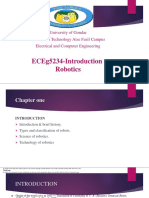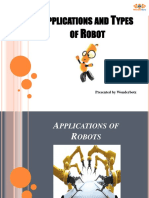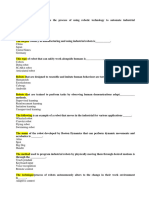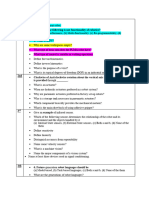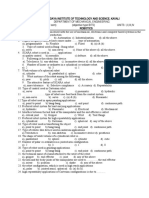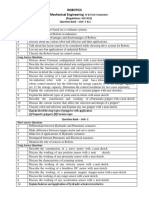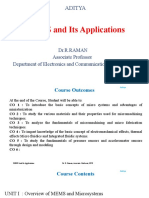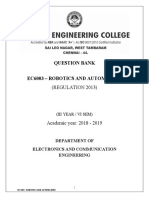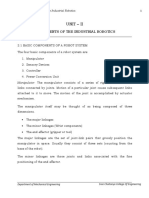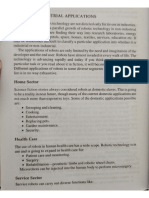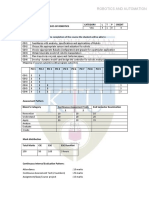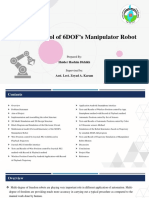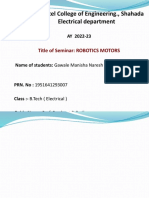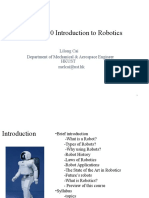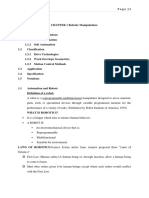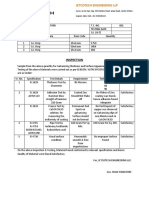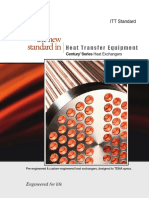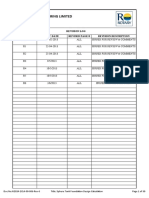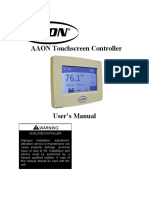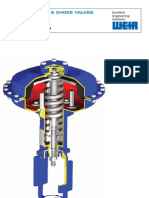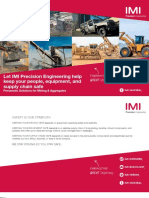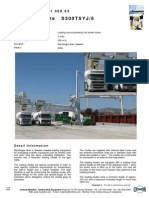Chap.
1 Introduction
Chapter 1 Introduction
Table of Contents
1. Introduction
2. Mathematical Preliminaries
3. Kinematics
4. Inverse Kinematics
5. Dynamics
6. Control
7. Mobile Robots
8. Intelligent Robots
1.1 Introduction
1.2 Applications of Robots
1.3 Robot Classification
1.4 Robot Structure
1.5 Research Areas
Objectives
In this chapter we introduce the field of robotics and look briefly at some applications.
This background material includes the following topics.
1) Applications of robotics, 2) Robot classification, 3) Robot structure,
4) Research areas.
Department of Electrical Eng..
Yeungnam University
�Chap. 1 Introduction
1.1 Introduction
History of the word Robot
The word Robot was first used in 1921 by the Czech
playwriter Karel Capek in his SF drama entitled R.U.R.
(Rossums Universal Robots).
It is derived from the Czech word robota.
(slave laborer, forced labor).
Karel apek(1890-1938)
Czech writer
A scene from Karel apeks 1920 play R.U.R. ),
showing three robots
Department of Electrical Eng..
Yeungnam University
�Chap. 1 Introduction
What is a robot?
Reprogrammable general-purpose entity with external sensors.
Software controllable mechanical device that uses sensors to guide
one or more end effectors through programmed motions in a
workspace in order to manipulate physical objects.
From practical point of view:
A robot is a versatile mechanical device equipped with actuators and
sensors under the control of a computing system.
TOPIO at Tokyo International Robot Exhibition (IREX) 2009.
Department of Electrical Eng..
Yeungnam University
�Chap. 1 Introduction
RT (Robot Technology)
1.1 Introduction
Fusion Technology
Electrical Eng., Mechanical Eng., Computer Sci., Linguistics,
Ethics, Psychology,
IT (Information Technology), BT (Bio Technology), NT (Nano
Technology), MEMS (Micro Electro Mechanical System), etc.
Technologies
in future or
in your mind
BT
IT
RT
Fusion Technology
NT
MEMS
Robot Technology
Department of Electrical Eng..
Yeungnam University
�Chap. 1 Introduction
Classes of robots
1.1 Introduction
According to the Japanese Industrial Robot Association(JIRA), Robots are
divided into the following classes.
Class 1
Manual handling device
Class 3
Variable sequence robot
Class 5
Numerical control robot
A device with several
degrees of freedom
actuated by the operator
The same type of handling
device as in class 2, but the
stages can be modified
easily.
The human operator
supplies the robot with a
movement program rather
than teaching it the task
manually.
Class 2
Fixed sequence robot
Class 4
Playback robot
Class 6
Intelligent robot
The human operator
performs the task
manually by leading or
controlling the robot,
which records the
trajectories.
A robot with the means to
understand its environment,
and the ability to
successfully complete a
task despite changes in the
surrounding conditions
under which it is to be
performed.
Handling device which
performs the successive
stages of a task according
to a predetermined,
unchanging method,
which is difficult to
modify
Department of Electrical Eng..
Yeungnam University
�Chap. 1 Introduction
1.1 Introduction
Roadmap of robots
In 1940s: Master- slave robot (Argonne Natl. Lab)
In 1950s : Programmable Manipulator (George C. Devol)
In 1959 : Industrial robot (The Unimate Robot)
In 1960s : MHT-Feedback System with sensors
In 1970s : Microprocessor based robot
In 1974 : T3 (The Tomorrow Tool) Industrial robot with computer control
In 1979 : SCARA robot (Japan) Assembly Robot
In 1980s : CIM (Computer Integrated Manufacturing)
In 1981 : Direct Drive Robot (Carnegie-Mellon Univ.)
In 1990s : Intelligent Robot
In 1999 : Aibo (Artificial Intelligent Robot, Sony)
In 2000s : Micro(Nano) robot, Network based robot,
In 2000 : Asimo (Honda)
In 2003 : Spirit (Opportunity) (NASA)
In 2006 : Big Dog (Boston Dynamics)
In 2006 : Stickybot (Stanford University)
In 2010s : Cloud Robot, Evolutionary Robot, ?
In 2100s : ?
Department of Electrical Eng..
Yeungnam University
�Chap. 1 Introduction
1.1 Introduction
Trends of robot technology
Intelligent
Intelligent/Agent
robot
Robot
Service
robot
2010 ~
Service
Robot
Museum
tour robot
Industrial
Robot
Human
guided
vehicle
Human
guided
robot
Auto
guided
vehicle
(AGV)
Entertainment
robot
Free ranging
mobile robot
2003
2000
1995
1990
Industrial robot
1985
1980
1962
Department of Electrical Eng..
Yeungnam University
�Chap. 1 Introduction
1.1 Introduction
U-IT based 9 Growth Engines, Korea
Broadband /
Home Network
IT SOC
Digital TV
Ministry of Information
and Communication
NG Mobile Comm.
/ Telematics
U-IT based
Next Gen. PC
9 Growth
Engines
Korea
Embedded SW
Intelligent Robot
Digital Contents
RFID / USN
Department of Electrical Eng..
Yeungnam University
�Chap. 1 Introduction
1.1 Introduction
Improvements
in sensor
technology
Vision
Force sensing
Environment recognition
Others
Technical
Off-line Programming
Safety
Multi-robots Cooperation
trends
in robots
Human-machine interface
Remote Operation
Others
Others
Improvements
in System
Technology
Source:
World robotics.org
Improvements
in
communication
The demand for robots is expected to rise rapidly due to factors such as the
increase in income, the advent of aging society and the pursuit of well-being.
Department of Electrical Eng..
Yeungnam University
�Chap. 1 Introduction
Robotics
Market
Department of Electrical Eng..
Yeungnam University
�Chap. 1 Introduction
Worldwide robotics Market shares
Applications
(unit : million $)
2009
2012
2015
1.1 Introduction
2020
Industrial Robots
16,450
20,020
25,620
41,250
Professional Service Robots
2,620
9,810
29,760
156,560
Personal Service Robots
9,810
23,260
52,040
222,410
Total
28,880
53,090
107,420
420,220
* Source: World Robotics 2007, IFR / WinterGreen Research, 2008, etc.
How
large is the current and future robotics market?
Source: http://servicerobotics.blogspot.com/
Department of Electrical Eng..
Yeungnam University
�Chap. 1 Introduction
Examples
1.1 Introduction
Example 1.1.1 What is the difference between Hard automation and Soft
automation?
Ans: Mass-production assembly lines were first introduced at the beginning of the
twentieth century(1905) by the Ford Motor Company.
- Hard automation: The machines and processes are more efficient, but
they have limited flexibility.
- Soft automation: flexible, ex) Programmable mechanical manipulators.
=> Robot
Department of Electrical Eng..
Yeungnam University
�Chap. 1 Introduction
1.1 Introduction
Review questions
Question 1.1.1 What is the difference between robot and crane?
Question 1.1.2 Explain some advantages and possible applications of masterslave robot .
Question 1.1.3 Explain why robotics is interdisciplinary.
Department of Electrical Eng..
Yeungnam University
�Chap. 1 Introduction
Question 1.1.4 Explain the operation of the centrifugal governor invented by
James Watt.
James Watts centrifugal governor
Centrifugal governor in a
Boulton & Watt engine of
1788 Department of Electrical Eng..
Yeungnam University
�Chap. 1 Introduction
1.1 Introduction
Question 1.1.5 Examine some notable specifications of Asimo in 2011.
Department of Electrical Eng..
Yeungnam University
�Chap. 1 Introduction
In 1940s: Master- slave robot (Argonne Natl. Lab)
Source: http://brl.ee.washington.edu/
Department of Electrical Eng..
Yeungnam University
�Chap. 1 Introduction
In 1979 : SCARA robot (Japan) Assembly Robot
Source: http://www.directindustry.com/
Department of Electrical Eng..
Yeungnam University
�Chap. 1 Introduction
In 1999: Aibo (Artificial Intelligent Robot, Sony)
Source: http://gizmodo.com/
Department of Electrical Eng..
Yeungnam University
�Chap. 1 Introduction
In 2000 : Asimo (Honda)
Source: http://commons.wikimedia.org/
Department of Electrical Eng..
Yeungnam University
�Chap. 1 Introduction
In 2006 : Big Dog (Boston Dynamics)
Source: http://www.slipstersblog.com/
Department of Electrical Eng..
Yeungnam University
�Chap. 1 Introduction
In 2003 : Spirit (Opportunity) (NASA)
Source: http://www.homotron.net/
Department of Electrical Eng..
Yeungnam University
�Chap. 1 Introduction
In 2006 Stickybot(Stanford Univ.)
Source: http://bdml.stanford.edu/
Department of Electrical Eng..
Yeungnam University
